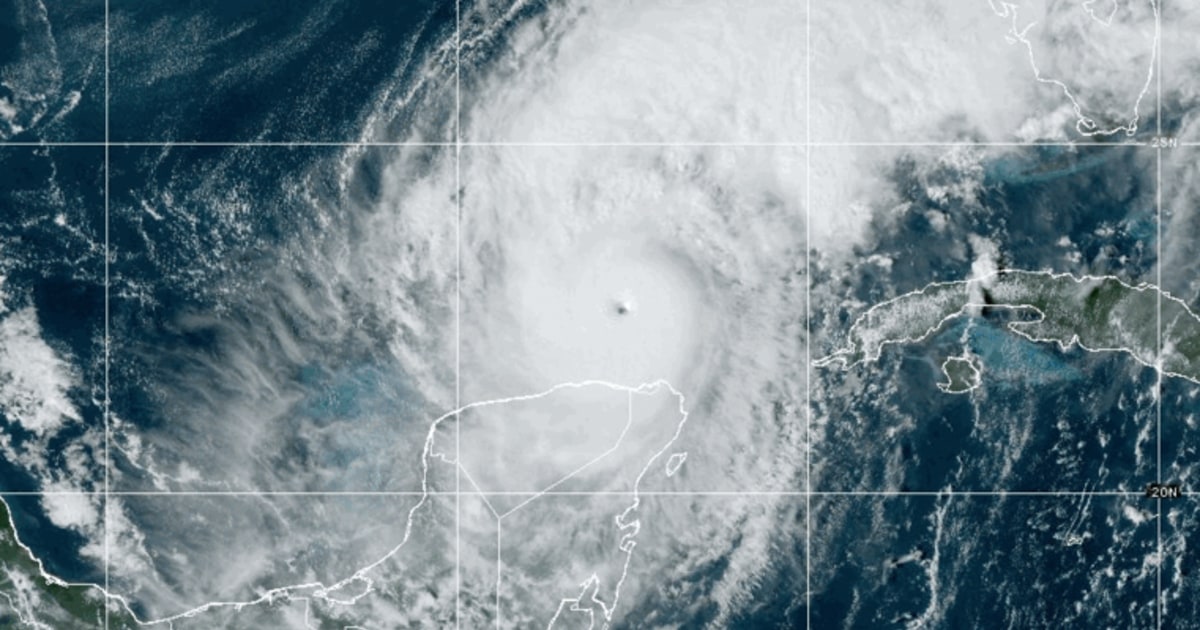Storm surge is the abnormal rise in water levels during a storm — a result of heavy hurricane winds pushing a bulge of water toward shore as depths become shallower. While winds are the primary cause of storm surge, it’s also affected by a storm’s angle of approach, the shape of the ocean floor and the low pressure within a storm, which slightly aids the bulging effect.
Because of the way storm surge can quickly inundate coastal locations and penetrate well inland, it’s typically one of the deadliest threats from a hurricane.
In the case of Hurricane Milton, the topography of Florida’s western coastline along the Gulf of Mexico contributes to the danger, since it isn’t very deep and it features a gentle underwater slope.
“The continental shelf is quite shallow,” Fritz said. “It doesn’t take a lot of force.”
Chris Slocum, a physical scientist with the National Oceanic and Atmospheric Administration’s Center for Satellite Applications and Research, said Milton is approaching from the southeast — an angle that will allow it to directly push water up the continental shelf.
On top of that, sea level rise as a result of climate change has also increased the region’s risk of flooding.
It’s not clear exactly where the storm will make landfall, and small changes can make a substantial difference for particular areas, like Tampa Bay.
On Tuesday evening, Milton “wobbled,” according to a forecast from the National Hurricane Center. Slight shifts are expected to continue as the storm nears land, which could alter its path by 5 to 10 miles. (In a forecast discussion, the National Hurricane Center said forecasts can be off by about 40 miles when a storm is 24 hours from potential landfall.
In a forecast discussion, the National Hurricane Center said forecasts can be off by about 40 miles when a storm is 24 hours from potential landfall.
Landfall is expected somewhere between Tampa Bay and Fort Myers, with the latest modeling suggesting that Milton’s eye could strike near Sarasota.
A major hurricane hasn’t hit Tampa Bay directly since 1921. A 2015 report from the risk modeling firm Karen Clark & Co. ranked it as the place most vulnerable to storm surge flooding from a hurricane in the U.S. Its underwater terrain, in particular, can act like a giant funnel, channeling and trapping floodwaters in the bay.
The city’s extensive urban development over the past century puts more people and coastal structures in harm’s way. The metropolitan area is home to more than 3 million residents.
“Milton has the potential to be one of the most destructive hurricanes on record for west-central Florida,” the National Hurricane Center said in an advisory on Tuesday.
Milton is expected to grow larger, and its winds should weaken as it nears land; both factors could influence how high storm surge gets.
“More intense storms are going to be able to move more water, and large storms are going to move more water,” Slocum said.
Local officials in Pinellas County, which includes the cities of Clearwater and St. Petersburg, called the forecast storm surge “not survivable” and urged residents to heed mandatory evacuation orders.
“This is the ocean coming into your living rooms,” Cathie Perkins, director of Pinellas County Emergency Management, said Tuesday in a news briefing. “This is fast, rising water with a lot of pressure behind it. So don’t think that you’re going to be able to ride that out.”
Even Florida’s east coast could get storm surge, since Milton is expected to traverse across the peninsula and remain a hurricane as it moves over the Atlantic Ocean once again. As it does, heavy winds will draw in on the low-pressure system, potentially pulling water onshore.
Northeast Florida could get 3 to 5 feet of storm surge, the hurricane center projects.
Storm surge is a serious concern with any major hurricane, which NOAA classifies as Category 3 or above. But even lower-ranked storms can generate catastrophic storm surge.
Hurricane Katrina, which reached Category 5 intensity but made landfall in Louisiana in 2005 as a Category 3 storm, produced a record 27.8-foot storm surge. In 2008, Hurricane Ike pummeled the Texas Gulf Coast as a Category 2 storm and generated a 15-foot storm surge in Galveston Island.


